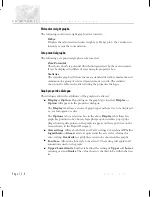
.
For samples that do not scatter much light, such as very small particles or
samples of low concentration, the amount of scattered light must be in-
creased. In this situation, the attenuator will allow more laser light through
to the sample.
.
For samples that scatter more light, such as large particles or samples of
higher concentration, the amount of scattered light must be decreased. This
is achieved by using the attenuator to reduce the amount of laser light that
passes through to the sample.
The appropriate attenuator position is automatically determined by the Zetasizer
during the measurement sequence.
The scattering intensity signal for the detector is passed to a digital signal
processing board called a
correlator
/
. The correlator compares the scattering
intensity at successive time intervals to derive the rate at which the intensity is
varying.
This correlator information is then passed to a
computer
0
, where the specialist
Zetasizer software will analyse the data and derive size information.
As mentioned earlier, depending upon the Zetasizer Nano model the detection
optics will either be arranged at positions of either 173° or 90°.
173° detection optics - Backscatter detection
The Zetasizer Nano Z, S and ZS measure the scattering information close to
180°. This is known as backscatter detection.
The application of the Backscatter detection is by a patented technology called
NIBS
(
N
on-
I
nvasive
B
ack-
S
catter).
Why measure backscatter? There are several advantages to doing this:
.
Because the backscatter is being measured, the incident beam does not have
to travel through the entire sample. This reduces an effect known as multi-
ple scattering, where the scattered light from one particle is itself scattered
by other particles. As the light passes through a shorter path length of the
sample, then higher concentrations of sample can be measured.
.
Contaminants such as dust particles within the dispersant are typically large
compared to the sample size. Large particles mainly scatter in the forward
C H A P T E R 1 3
Z
e
t
a
s
i
z
e
r
N
a
n
o
S
e
r
i
e
s
P a g e 1 3 . 7
Laser
Sample
Detector
173°
ILL
6097
Summary of Contents for Zetasizer Nano Series
Page 7: ...Part 1 Operators guide Part 1 Operators guide...
Page 8: ......
Page 9: ...Introduction to this manual Introduction to this manual C H A P T E R 1...
Page 10: ......
Page 16: ...C H A P T E R 1 Z e t a s i z e r N a n o S e r i e s Page 1 6 M A N 0 3 1 7...
Page 17: ...What is the Zetasizer Nano What is the Zetasizer Nano C H A P T E R 2...
Page 18: ......
Page 26: ...C H A P T E R 2 Z e t a s i z e r N a n o S e r i e s Page 2 8 M A N 0 3 1 7...
Page 27: ...How does the Zetasizer Nano work How does the Zetasizer Nano work C H A P T E R 3...
Page 28: ......
Page 51: ...Making measurements A tutorial Making measurements A tutorial C H A P T E R 4...
Page 52: ......
Page 78: ......
Page 90: ...C H A P T E R 5 Z e t a s i z e r N a n o S e r i e s Page 5 12 M A N 0 3 1 7...
Page 91: ...Sample Preparation Sample Preparation C H A P T E R 6...
Page 92: ......
Page 100: ...C H A P T E R 6 Z e t a s i z e r N a n o S e r i e s Page 6 8 M A N 0 3 1 7...
Page 101: ...Maintenance Maintenance C H A P T E R 7...
Page 102: ......
Page 107: ...Part 2 Supervisors guide Part 2 Supervisors guide...
Page 108: ......
Page 109: ...Security Security C H A P T E R 8...
Page 110: ......
Page 118: ...C H A P T E R 8 Z e t a s i z e r N a n o S e r i e s Page 8 8 M A N 0 3 1 7...
Page 119: ...Using SOPs Using SOPs C H A P T E R 9...
Page 120: ......
Page 152: ......
Page 161: ...Exporting results Exporting results C H A P T E R 1 1...
Page 162: ......
Page 168: ...C H A P T E R 1 1 Z e t a s i z e r N a n o S e r i e s Page 11 6 M A N 0 3 1 7...
Page 169: ...Creating custom reports Creating custom reports C H A P T E R 1 2...
Page 170: ......
Page 183: ...Size theory Size theory C H A P T E R 1 3...
Page 184: ......
Page 193: ...Molecular Weight theory Molecular Weight theory C H A P T E R 1 4...
Page 194: ......
Page 200: ...C H A P T E R 1 4 Z e t a s i z e r N a n o S e r i e s Page 14 6 M A N 0 3 1 7...
Page 201: ...Zeta Potential theory Zeta Potential theory C H A P T E R 1 5...
Page 202: ......
Page 215: ...Part 3 Appendices Part 3 Appendices...
Page 216: ......
Page 217: ...Health and Safety Health and Safety A P P E N D I X A...
Page 218: ......
Page 223: ...Specification Specification A P P E N D I X B...
Page 224: ......
Page 227: ...Site requirements f r o m M A N 0 3 1 7 I s s u e 1 0 Site requirements A P P E N D I X C...
Page 237: ...Installation Installation A P P E N D I X E...
Page 238: ......
Page 241: ...Regulatory Statements Regulatory Statements A P P E N D I X F...
Page 242: ......
Page 246: ...A P P E N D I X F Z e t a s i z e r N a n o S e r i e s Page F 4 M A N 0 3 1 7...
Page 247: ...Index Index...
Page 248: ......
















































